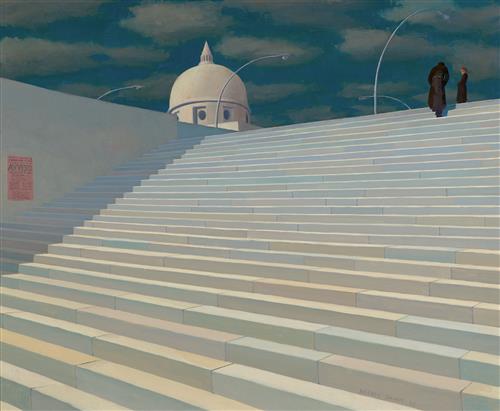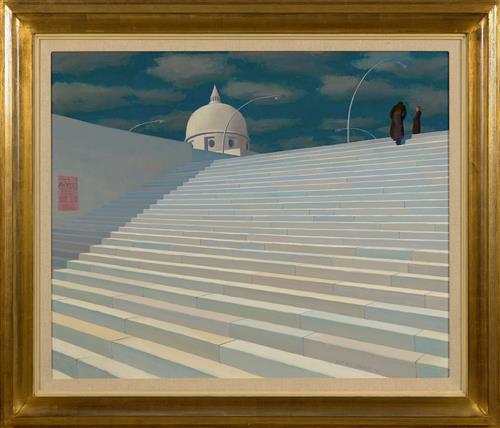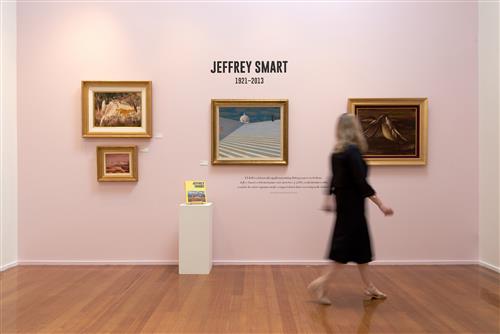Lot 21
E.U.R. II 1965
oil on board
signed and dated lower right: JEFFREY SMART 65
inscribed verso: Reserved/ E.U.R. II/ 10. CUT DOWN TO SIZE
Charles Hewitt Frames label verso
unknown partial gallery label verso
65.5 x 80cm
Estimate $250,000 - $350,000
Please contact the Art Department for a condition report on this lot.
The opinions expressed in the condition reports are a guide only and should not be treated as a statement of fact. Prospective buyers are encouraged to physically inspect item, or book a virtual viewing or request further images during our pre-sale period where Leonard Joel staff are available for advice.
Please note condition reports can be amended during the pre-sale period, so we strongly suggest any interested bidders check the published condition report available on the website before the auction commences. Leonard Joel makes no guarantee of the originality of mechanical or applied components. Absence of reference to such modifications does not imply that a lot is free from modifications.
South Yarra Gallery, Melbourne
Osborne Galleries, Adelaide, acquired from the above in 1966
The Macquarie Galleries, Sydney 1969 (accompanied by original purchase invoice)
The Gordon and Jackie Samuels Collection, Sydney
Jeffrey Smart, Galleria 88, Rome, 8-23 April 1965, cat. no. 23
Exhibition of paintings: Jeffrey Smart, Macquarie Galleries, Sydney, 29 September-11 October 1965, cat. no. 4, 185 Gns
Jeffrey Smart, South Yarra Gallery, Melbourne, 19 April 1966, cat no. 2, $420.00
Quartermaine, P., Jeffrey Smart, Gryphon Books, South Yarra, 1983, p.109, no. 440
RELATED WORKS:
Study for E.U.R.II 1964, black fibre-tipped pen on Japanese cream wove paper, 10 x 13.9cm sheet, The Collection of the Art Gallery of New South Wales, Sydney
E.U.R. I 1965, oil on canvas, 64 x 81cm, The Collection of the Newcastle Art Gallery, New South Wales
Study for E.U.R.I 1964, black fibre-tipped pen on Japanese cream wove paper, 10 x 13.9cm sheet, The Collection of the Art Gallery of New South Wales, Sydney
We are grateful to Stephen Rogers, Archivist for the Estate of Jeffrey Smart, for his kind assistance with cataloguing this painting.
Strong works of art are a solitary transport. By an uncanny imaginative chemistry, they sweep the viewer into an alluring moody painted world. Take Jeffrey Smart's E.U.R. II. So little is shown, yet somehow it suggests you are within an ultra-modern city. The sky is overcast. It is a somewhat grey afternoon. All is so poised and still. You are outdoors, probably in a municipal district, near the base of broad stone stairs designed for crowds. Those stairs crop what is visible, preventing any view of the locality. Nevertheless, your eye is drawn by the stately minimalist dome of an unseen building. Exuding authority, that unadorned concrete dome juts into sight, well above you to the left in middle distance. It has an almost magnetic attraction, pulling the eye back when you look away. There are a couple of youngish priests in cassocks higher up on the right, evidently walking to an unseen building, but otherwise this scene is uncannily deserted.
E.U.R. II marked a defining point in Jeffrey Smart's output. This is where his mature style emerges. Up until now the artist had been composing pictures out of details from different Sydney suburbs, splicing them together in streetscapes with a sense of the mysterious. But he aspired to do much more. Ambition prompted him to leave Australia and go to Rome, a city brimming with cultural stimulus, although inspiration came from an unexpected source.
Italy was in a construction boom. Moving into a shared flat in Rome with the expatriate painters Justin O'Brien, Brian Dunlop and Ian Bent, the artist was quite taken by the brash modern developments close by: 'We were near the periphery and I started roaming around these outskirts,' Smart explained. 'It was dramatic: you would be surrounded by blocks of ten-storey flats and the next moment be in open fields.' (1) Slick new offices stuck out amid historic buildings on old streetscapes. The artist had encountered nothing like this in Australia. Sketchbook in hand he wandered Rome's residential and industrial estates, filling page after page with visual fragments of 1960s Italy.
Smart was especially taken with the ultra-modern suburb E.U.R. (shortened from Esposizione Universale Roma). While he already knew E.U.R. as the bleak setting for Michelangelo Antonioni's award-winning recent film L'Eclisse (1962), Smart told me on visiting the estate he was transfixed. (2) It was as if he had stepped into a city of the future. There wasn't a single old building in this showcase contemporary estate, a mix of minimalist office and apartment blocks with austere adjacent parklands. Then, turning a corner, Smart caught sight of the church of Santi Pietro e Paolo. Lacking ornamental flourishes, this blocky statement in pure geometry was designed by Arnaldo Foschini and set on a rise above the E.U.R. estate. Many Italians loathed the church. Calling it a secularist eyesore, they objected to the absence of religious adornment: there wasn't even a crucifix atop its modernist dome. The artist looked, scrutinised, drew.
Smart spoke of his first visit to E.U.R. as a transforming experience. He came away intending to make a stirring portrayal of a wholly modern city. No dishevelled older buildings would be included, the stress being on infusing urban progress with a jarring sense of the uncanny. The artist designed a major composition using two architectural keynotes of the estate: the steps outside a museum and the dome on the controversial church. Trees and lawns were absent, no trace of nature intruded in a grey artificial world. Fascinated by the E.U.R. dome's geometry-how cone sat on hemisphere sat on tube-Smart tinkered until the proportions of different elements worked together; as he later explained 'My pictures are completely synthetic in that I move things around relentlessly, change the heights of buildings, the colours, to get the composition right.' (3)
This is why overall tone is ordered into three compositional sections within E.U.R. II. The darkest tone is set by the sky in an upper pentilateral; the mid-tone fills a shadow made by a wall on the composition's left; while a dominant pale tone fill the foreground and lower section spreading to right. Against this neat distribution of tones, full sunlight falls upon the dome, making it the centre of pictorial attention.
Most striking about E.U.R. II is the handling of geometry. Smart uses lines made by architectural edges to lead the eye around the composition, ensuring that we keep coming back to that dome. Notice how straight lines made by the upper edge of the wall on the left, the top of the stairs, and the base of the shadow at left all run straight to the dome. Then there is how Smart has slender street lights along the top of the composition echo the curve of the dome. Whenever the eye wanders, Smart's pictorial geometry keeps bringing it back to the minimalist dome rising above the unseen estate.
When his plan was perfected, Smart was so taken with the composition he painted two near identical canvases. The chief differences between them are that E.U.R. II has two priests stand high on those stairs to the right, as well as a reddish notice board-the sole splash of muted colour-on a wall against the picture's the left edge, whereas the other canvas, E.U.R. I, has a young man sit reading a book on the stairs at the upper left. (Smart used his flatmates for the figures, Justin O'Brien posing for both priests, and Ian Bent for the reading man.)
E.U.R. II is an historically significant painting. Taking progress as its theme, Jeffrey Smart's celebrated mature style starts here. Henceforth the artist would portray futuristic townscapes with an unsettling edginess: 'I find myself moved by man in this new violent environment,' he explained in the leading European journal Art International, adding 'I want to paint this explicitly and beautifully.' (4) To this end, E.U.R. II employs what would be Smart's new pictorial vocabulary, being derived from the minimalist language and materials of the modern architecture, especially its emphasis on overt geometric forms. Indeed, E.U.R. II also introduces what would be the artist's signature motif: a cropped church dome seen rising in the distance.
Dr. Christopher Heathcote
(1) Jeffrey Smart, Not Quite Straight: A Memoir, William Heinemann, Port Melbourne, 1996, p.383.
(2) On 26 April 2008 I interviewed Jeffrey Smart. The second question I asked was whether the EUR estate in Rome was an influence on his townscapes. His long, enthusiastic reply is the basis for this entry on the painting EUR II.
(3) Quoted in Barry Pearce, Jeffrey Smart: A Retrospective, Art Gallery of NSW, Sydney, 1999, p.178.
(4) Jeffrey Smart, Art International, XII.5 (May 1968). p.47.
© The Estate of Jeffrey Smart
Fine Art
AUCTION
Sale: LJ9450
6:00pm - 22 March 2022
333 Malvern Rd, South Yarra 3141
VIEWING
Friday 18 - Sunday 20 March, 10am - 4pm
333 Malvern Road, South Yarra VIC
CONTACT
Olivia Fuller
olivia.fuller@leonardjoel.com.au


